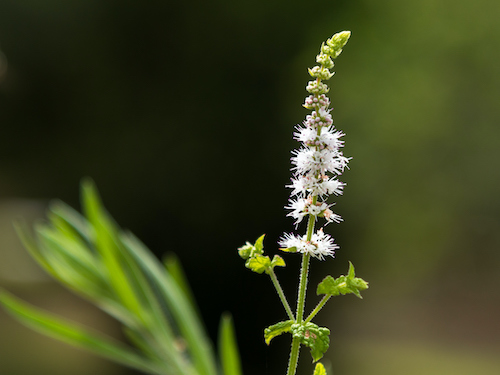By Dr. Sharon Stills, NMD
Certain foods and drinks can actually bring on hot flashes and night sweats. But if that’s the bad news, then the good news is: the right food choices help prevent them.

From caffeine and red wine, to Mexican food and sugary treats, some foods and ingredients are well-established hot flash triggers. Choosing the right foods can support the continual balancing act your body performs to keep peace between your major and minor hormones. Creating and maintaining hormonal balance is the best way to prevent hot flashes and night sweats, and food can help you do just that.
#1 Protein fights hot flashes
Hot flash-fighting snacks
Weird but wonderful!
- Broccoli sprouts or other veggies in a salad, omelet or a whole-grain wrap
- Roasted soy nuts
- Cauliflower, and celery sticks dipped in Creamy Tofu-Garlic Dip (recipe below)
- Old-fashioned oatmeal with ground flax seeds and soy milk
- Soy milk smoothie, blended with ice and dark-colored berries
- Chamomile tea, iced
Protein is one of the most important raw materials required to make and balance hormones. You want to get enough (around 20% of your total daily calories) but not too much. Seafood, especially wild-caught, and organic/grass-fed meats, eggs and yogurt are good sources of animal protein and healthy fats.
Great plant-based proteins include nuts and nut butters, freshly-ground flax seeds, lentils and other legumes like peas, beans and peanuts. We like plant choices because they provide more than protein. They also deliver healthy fats, lots of fiber, and the phytochemicals needed to synthesize, metabolize, and balance your hormones.
Other options to consider for hot flash prevention and reduction are whole, non-GMO soy foods. Soy foods meet your needs for protein intake and offer isoflavones that are beneficial for women in menopause. Soy-based foods are not for everyone, but when it comes to cooling down vasomotor symptoms like hot flashes, soy is a menopause superfood.
#2 Eat the right fat for fewer hot flashes!
Dietary fats, especially cholesterol, have gotten a bad rap over the years but we now know that you need certain fats to be healthy. Cholesterol in the right forms is absolutely essential for steroid hormone production. In fact, your body uses cholesterol as the “mother molecule” for making sex hormones and stress hormones. Your liver can make all the cholesterol your body needs for this and other functions.
Another type of fat we can’t live without are essential fatty acids (EFAs). Olive oil, nuts, salmon and avocado are all rich in healthy, hormone-balancing fats. New research suggests omega-3s in particular can help diminish the frequency of hot flashes in menopause.

#3 Vegetables prevent hot flashes and night sweats
For hot-flashing women, it’s pretty hard to beat the benefits you get from eating lots of vegetables. Vegetables contain the ideal fiber for healthy digestion, weight and hormonal balance. Fiber is the favorite food of GI flora.
When you feed good gut bacteria, they help you absorb nutrients and metabolize sex hormones. Getting plenty of fiber also prevents the sharp insulin spikes that can contribute to hot flashes. Insulin is one of the body’s major hormones so when it’s balanced, balancing your other hormones is much easier, especially during menopause.
Creamy garlic tofu dip
1 14-oz tub of soft or silken tofu
2 tsp. toasted sesame oil
1 Tbsp. cider vinegar
½ tsp. dry mustard
½ tsp. iodized sea salt
1 tsp. tamari or soy sauce
2 cloves of garlic
Whip all ingredients in a blender or food processor. Chill and use as a dip for raw or steamed veggies, chips, or whole-grain pita.
Many fruits and vegetables are also supercharged with “phytoestrogens” that are particularly beneficial to women with perimenopause and menopause symptoms like hot flashes. Phytoestrogens include isoflavones and lignans. All phytoestrogens work gently with your body to recalibrate hormonal balance at the cellular level.
Soybeans are one of the classic phytoestrogen-rich foods because they contain isoflavones. Flax seeds are another great choice because they’re high in lignans. Grind up 1–3 tablespoons of flax seeds every day and add them to soups, salads and smoothies. You also get phytoestrogens in parsley, fennel, celery, garlic, onions, and all sorts of seeds, nuts and legumes.
Other vegetables that help with hormonal imbalance are the crucifers: broccoli, Brussels sprouts, cauliflower, radishes, cabbage, collards, kale and watercress. Crucifers contain glucosinolates, or sulfur-containing compounds, that help with detoxification.
To help reduce hot flashes and balance your hormones, you can’t do better than to eat a heaping helping of greens every day. It’s hard to overstate the other wellness benefits of eating lots of veggies!
Some fruits do contain phytoestrogens and other important compounds, but most are also high in sugar. You can still eat fruit in moderation — it makes a nice, filling snack. Just watch to see if it leads to any hot flash activity for you.
#4 Don’t eat these hot flash trigger foods
If your current diet is high in white sugar, white bread, pasta, or processed foods you may inadvertently be fueling more hot flashes and night sweats. Leave those foods on the shelf, at least for now.
Other hot flash trigger foods to avoid include:
- Caffeinated drinks
- Chocolate
- Red wine
- Aged cheeses
- Fried foods
- Spicy dishes
When it comes to preventing hot flashes and night sweats, it’s really important to know how different foods affect your body. Everyone’s different and certain foods may set off the chain of events that end in a blazing hot flash.
For a few weeks, you can keep a journal of what and when you eat and drink, and how you feel afterward. If you notice a connection between a certain food and your hot flashes (or another symptom) take it out of rotation temporarily.
Balance your diet for fewer hot flashes
During menopause, it’s important to eat a balanced diet of quality protein, healthy fats, and phytonutrient-rich fruits and vegetables. Don’t skip meals or snacks, especially if you’re watching your weight. Whenever you can, add in exercise and determine what works for you to get adequate sleep. Reduce stress as much as possible — it’s the top trigger for hot flashes and night sweats.
Supplement your diet to fill in nutrient gaps, balance hormones and support digestion with a top-quality multivitamin-mineral, a good omega-3 supplement and a strong probiotic. Try all three for a few months to see just how big a difference they can make. For more information about what to eat for good hormonal balance, check out our nutrition and lifestyle guidelines.
Thousands of women with hot flashes and night sweats have had success with our popular Herbal Equilibrium. With a select blend of adaptogenic herbs that promote hormonal balance, this supplement offers natural and lasting relief for other menopause symptoms as well.
Examining your diet and making a few food swaps can quiet symptoms of hormonal imbalance like hot flashes and night sweats. Those same food selections will also help relieve anxiety, irritability, fatigue and sleeplessness, too. Never underestimate the power of food to make you feel better!
https://www.health.harvard.edu/how-much-protein-do-you-need-every-day-201506188096
https://www.heart.org/HEARTORG/Conditions/Cholesterol/AboutCholesterol/About-Cholesterol_UCM_001220_Article.jsp#.WN1erGe1tpg
1 Schwarzbein, D. 1999. The Schwarzbein Principle, 24. Deerfield Beech, FL: Health Communications, Inc.
Lucas, M., et al. 2009. Effects of ethyl-eicosapentaenoic acid omega-3 fatty acid supplementation on hot flashes and quality of life among middle-aged women: A double-blind, placebo-controlled, randomized clinical trial. Menopause, 16 (2), 357–366. URL (abstract): https://www.ncbi.nlm.nih.gov/pubmed/19034052 (accessed 05.06.2010).
Low, Y-L., et al. 2007. Phytoestrogen exposure is associated with circulating sex hormone levels in postmenopausal women and interact with ESR1 and NR1I2 gene variants. Cancer Epidemiol. Biomarkers Prev., 16 (5), 1009–1016. URL: https://cebp.aacrjournals.org/content/16/5/1009.long (accessed 10.22.2010).
Goldin, B. 1986. In situ bacterial metabolism and colon mutagens. The intestinal microflora and the enterohepatic circulation of sex steroid hormones. Ann. Ref. Microbiol., 40, 382. URL: https://www.annualreviews.org/doi/abs/10.1146/annurev.mi.40.100186.002055?journalCode=micro (accessed 10.22.2010).
Phytoestrogen data source
Thompson, L., et al. 2006. Phytoestrogen content of foods consumed in Canada, including isoflavones, lignans and coumestan. Nutr. Cancer, 54 (2), 184–201. URL (abstract): https://www.ncbi.nlm.nih.gov/pubmed/16898863 (accessed 10.21.2010).
Lignan data source
Milder, I., et al. 2005. Lignan contents of Dutch plant foods: A database including lariciresinol, pinoresinol, secoisolariciresinol, and matairesinol. Br. J. Nutr., 93 (3), 393–402. URL (abstract): https://journals.cambridge.org/action/displayAbstract?fromPage=online&aid=918612 (accessed 10.21.2010).
References on broccoli, sulforaphanes, and detoxification enzymes
Brooks, J., et al. 2001. Potent induction of phase 2 enzymes in human prostate cells by sulforaphane. Cancer Epidemiol. Biomarkers Prev., 10, 949–954. URL: https://cebp.aacrjournals.org/content/10/9/949.long (accessed 10.22.2010).
Conaway, C., et al. 2000. Disposition of glucosinolates and sulforaphane in humans after ingestion of steamed and fresh broccoli. Nutr. Cancer, 38, 168–178. Erratum in: Nutr. Cancer, 2001;41, 196. URL (abstract): https://www.ncbi.nlm.nih.gov/pubmed/11525594 (accessed 10.22.2010).










